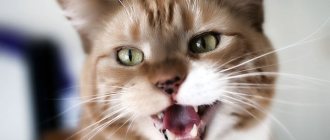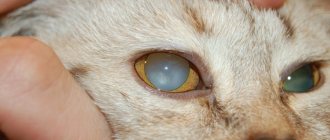Melena, a term used to describe black, tarry stool, is usually caused by bleeding in the upper part of the gastrointestinal tract. This is also seen in cats after they have ingested a sufficient amount of blood from the mouth or respiratory tract.
Black stool itself is not a disease, but a symptom of some other underlying disease. The dark color of blood occurs due to the oxidation of iron in hemoglobin (the oxygen that carries the pigment in red blood cells) as it passes through the small and large intestines.
Cat fecal norms
Healthy cats have bowel movements 1-2 times a day. The following parameters of a pet's stool are considered normal:
- Color. A healthy cat's feces are brown, but the color may change to lighter or darker. With an abundance of dairy products in the diet, the shade becomes lighter. If a cat eats a lot of raw meat, the stool will darken. Discolored stool is a symptom of hepatitis, and it becomes greenish due to taking antibiotics or sulfonamides.
- Consistency. Normal cat stool has a firm consistency. It is well designed, does not crumble, and has a smooth surface. Small, hard pieces indicate dehydration and disruption of the large intestine. Unformed stool may indicate the presence of an infection in the body, intoxication, or excessive intestinal motility.
- Smell. Usually the stool has a characteristic, but not pungent odor. If the feces smell putrid, it means the cat has impaired protein absorption and may have ulcerative colitis. A smell similar to old spoiled oil may be a sign of a problem with the pancreas or improper flow of bile. The sour smell occurs due to fermentation and improper absorption of fats.
Healthy cats have bowel movements 1-2 times a day.
Diagnostics and therapy
So we found out why cats have black diarrhea. If you observe, in addition to the melena itself, the following signs, you should immediately run to the vet:
- Diarrhea.
- Vomit.
- Pale gums.
- Presence of bruising or other areas of bleeding (indicates coagulopathy).
- Weight loss.
- Poor appetite.
- Excessive drinking and “exorbitant” volumes of urine.
To find out the root cause of what is happening to the cat, the veterinarian will resort to various diagnostic techniques, including x-rays, ultrasound, blood and urine tests , as well as other methods. How is the treatment done? Since melena is not a disease, but only its symptom, the primary pathology that directly leads to intestinal bleeding is treated.
But in any case, the veterinarian will first solve the problem of blood loss. Of course, ideally, a sick pet needs a transfusion, but in a veterinary clinic this is almost unrealistic. We do not have blood banks, and targeted blood collection is carried out only in the largest veterinary centers. So blood loss is partially replaced with plasma or even saline. The main thing is to prevent collapse and reduce the load on the body’s blood depots.
Causes of changes in stool color
If changes appear in the cat's litter box, you need to analyze the pet's condition and diet. Black stools are not always a sign of illness.
Physiological reasons
There are a number of factors that change the color of stool, but do not pose a threat to the pet’s health:
- Iron. A trace element that enters the body as part of a supplement reacts with food and can change the color of intestinal masses. If the stool becomes colored, you should stop using the drug.
- Meat. If a cat has a heavy meal of raw meat or liver, this will certainly lead to darkening of the stool, since these products contain a lot of iron. If an animal eats raw meat on a regular basis, the stool will always be black. In addition, frequent consumption of raw meat increases the risk of infection with worms.
- Dyes, preparations with pigment. If a cat is given activated charcoal or eats cherries, the feces will darken.
- Changes in the color and consistency of your cat's stool can also be caused by stress.
Although the listed factors do not threaten the health of the purr, measures should be taken to prevent the situation from reoccurring. A diet based on raw meat, in addition to the risk of infection with helminths and microbes, is dangerous due to excess protein and lack of fiber.
Changes in your kitten's stool should be taken especially seriously. The weak body of a baby is more susceptible to diseases compared to adult cats.
Physiological reasons for changes in stool color
Pathological causes
There are a number of factors that cannot be ignored. Some of them, such as internal bleeding, can cost the fluffy his life.
Worm infestation
Parasites usually inhabit the small intestine. To get nutrition, they cling to the intestinal walls and disrupt the integrity of the internal mucous membrane. As a result, slight bleeding appears. Blood is digested along with food and colors the stool.
Hemorrhagic gastroenteritis
This inflammatory disease is characterized by detachment of capillaries and internal linings of the gastrointestinal tract, followed by bleeding. The causes of the pathology are:
- poor blood clotting;
- panleukopenia;
- stress;
- autoimmune disease;
- food intolerance.
Traumatic gastritis or colitis
The inner linings of the stomach and intestines are scratched by hard objects that enter the body. Cracks and ulcers form on the mucous membranes. The wounds bleed, and the blood that gets into the gastrointestinal tract changes the color of the stool.
Poor nutrition is the main cause of injury to internal organs
Ulcerative gastritis, ulcerative enterocolitis
An ulcer of any nature is a wound, only inside an organ. Every wound bleeds, especially if the pet receives food that is not suitable for its condition.
Tumors of the stomach and small intestine
During the formation and growth of a tumor, especially a malignant one, the mucous membranes of organs are destroyed, capillaries burst, and bleeding begins.
Postoperative hemorrhage
If your pet has undergone surgery, after which the animal's stool turns black, this may indicate bleeding from the internal sutures. Blue-black stool color is a sign of heavy blood loss.
Symptoms
If there are serious pathological conditions in the cat’s body, in addition to black stool, it may develop symptoms in the form of black or red vomit, bleeding from the anus, general malaise due to constant blood loss, nausea, and acute pain in the abdominal cavity. It is necessary to take into account the fact that black discharge is feces with admixtures of coagulated blood, which means the reason lies in problems with the upper gastrointestinal tract. Red stool, on the contrary, indicates problems in the lower gastrointestinal tract, because more fresh blood is released in the feces.
Sometimes, black stools may alternate with red ones. This happens when the color of the blood changes, which has interacted with digestive enzymes.
Dangerous symptoms
A pet's health can be determined in part by its behavior. If a cat has black stool, but the pet is active and affectionate as usual, and willingly accepts play, most likely the cause of the change in stool is physiological factors. However, the presence of a number of symptoms against the background of black stool indicates serious problems and requires immediate medical consultation:
- Stool with blood clots. This is a clear sign of heavy internal bleeding. His life depends on the speed of helping the purr.
- Unusual pet behavior. If a cat meows pitifully and the scream intensifies when you try to touch his stomach, this indicates a pain syndrome. An additional sign of pain is a slight trembling throughout the animal’s body.
- Temperature increase.
- Vomiting and/or false urges.
- Weakness. A bad sign is the fluffy's apathy, when he shows no interest in what is happening and simply lies indifferently.
- Deterioration of appetite, complete refusal of food.
- Extreme thirst or refusal to drink water.
- Frequent urge to urinate.
- Pale gums.
- Formation of wounds and bruises on the body.
Loose, black stool is called melena and is a sign of heavy bleeding.
The animal may be prescribed IVs to replenish lost fluid.
Diarrhea symptoms
If the color of the bowel movements deviates from the norm, and your pet is losing a lot of hair, you should consult a specialist.
Cat feces that differ from the norm in color and consistency are already a pathological sign, indicating that not everything is in order with the pet’s body. Other symptoms that require immediate action:
- violation of general condition;
- nausea accompanied by vomiting;
- weakness, drowsiness, apathy;
- increased gas formation;
- persistent constipation or, conversely, diarrhea;
- increased body temperature;
- abdominal pain on palpation;
- blanching or yellowing of the mucous membrane;
- dullness and excessive hair loss;
- lack of appetite;
- rapid weight loss.
Regardless of the etiology (i.e. origin) of diarrhea, all its types can be divided into two large types:
- Acute diarrhea.
- Chronic diarrhea.
Accordingly, the symptoms of these two varieties will differ significantly.
In this case, everything is quite simple and clear. First, you need to decide on the terminology: “acute” diarrhea is called in cases where it began suddenly and lasts no more than two days, accompanied by a significant deterioration in the condition of the sick animal.
The following signs of such diarrhea are distinguished:
Defecation is frequent, the animal constantly runs to the tray.
As a rule, feces are liquid; they often contain impurities in the form of mucus, half-digested pieces of food, and sometimes blood can be seen.
After just five or six trips to the potty, the animal begins to meow hoarsely, constantly licking the anus area.
If diarrhea continues for more than two days, the cat becomes noticeably weaker. In the most severe cases, the pet practically stops grooming itself, its fur becomes matted and becomes covered with a crust of dried feces.
In the same cases, severe blanching of all visible mucous membranes is observed. They become dry and sticky to the touch. The skin loses its elasticity, the coat becomes rough and hard.
The following conclusions can be drawn from all of the above:
If diarrhea lasts less than a day, and the general condition of the animal at this time remains stable and does not cause alarm, you can try to cope with diarrhea on your own.
In cases where a cat suffers from diarrhea for more than a day, and its condition is slowly but deteriorating, you should definitely show the animal to a veterinarian
This precaution will probably not be superfluous.
This type of pathology manifests itself somewhat differently:
Diarrhea occurs sporadically, not every day.
Interestingly, cases of diarrhea may well alternate with periods of “impenetrable” constipation.
The cat’s condition “by eye” remains normal, but this impression is wrong. If nothing is done and the true root cause is not identified, the animal will gradually develop exhaustion.
Diagnostic methods
A thorough examination is required to make a diagnosis and prescribe therapy. First of all, the doctor must find out from the cat’s owners when and under what circumstances the changes began. The diet, previous diseases and features of the clinical picture are refined. After a general examination and temperature measurement, the following diagnostic methods are used in veterinary medicine:
- Analyzes. The cat's blood, urine and feces are taken for examination. The test results allow us to determine the general condition of the furry, the presence of parasites, liver and gallbladder diseases, and poisoning.
- Coagulogram. A study to determine the rate of blood clotting.
- Gastroscopy. Makes it possible to see the true condition of the inner walls of the stomach, detect ulcers or erosion, foreign bodies.
- Ultrasound of the peritoneum. Allows you to determine the presence of neoplasms and cysts, stones or sand in the gallbladder, and intestinal obstruction.
- Radiography. Detects liver enlargement and the presence of tumors.
- Biopsy. If a tumor is detected, the affected tissue is collected for analysis. Against the background of black feces and the accompanying clinic, the liver often suffers.
General examination Clinical examination Ultrasound of the peritoneum
Price issue
Let's talk about the cost of the listed drugs. The same Prazitel is sold in veterinary pharmacies or hospitals. The price starts from 80 rubles per tablet or from 170 rubles per suspension.
“Drontal” in tablets will cost the animal owner 320-400 rubles, depending on the region of residence.
"Pratel" is a rather expensive drug. For ten tablets you will have to pay from 450 to 600 rubles.
"Dirofen" costs about 120-150 rubles.
The rest of the drugs are sold in regular, human pharmacies. Price categories are quite different, depending on the region where the pharmacy is located.
Treatment for black stools
Treatment methods and the use of medications depend on the diagnosis. In general, treatment is carried out as follows:
- Stop bleeding. This is the first priority. Losing a large amount of blood can be fatal. Purr is prescribed hemostatic drugs: “Vikasol”, “Ditsinon”. It is important to follow the dosage prescribed by your doctor, otherwise the risk of blood vessel blockage with blood clots increases.
- Elimination of the cause of the pathology. If a cyst or foreign body is detected in the gastrointestinal tract, surgical intervention is prescribed.
- Deworming. Even if the cause of the bleeding was not parasites, but the infection was discovered through tests, the cat must be given anthelmintic drugs.
- Antibacterial therapy. The purr is prescribed antibiotics, antiviral drugs and immunomodulators if the cause of the pathology is an infectious disease.
- Elimination of ulcers. When ulcers are detected, gastroprotectors are used, for example, Almagel, Phosphalugel.
Table: Effective treatment methods
Therapy will be effective only after identifying the cause of the change in stool. Attempting to treat your pet on your own without medical advice is dangerous for the animal’s life.
Depending on the cause and condition of the cat, he may be prescribed IVs to replenish lost fluid and vitamin injections. However, treatment cannot begin until the bleeding has stopped.
Black stool is not a separate disease, but a symptom of a large number of pathologies, but most often the cause is internal bleeding. In order to provide timely assistance to your pet, you should be attentive to cleaning the litter box, studying the cat's stool, its color, consistency, and the presence of parasite particles in it. Don't panic if your pet's behavior doesn't change.
Recommended Posts
What to do if your cat has blood in the stool: causes, diagnosis and treatment
Causes and treatment options for diarrhea in cats
What to do if your cat has a big belly: causes, treatment and prevention
A cat scratches its neck: possible causes of itching and methods of treatment
Common ear sores in cats: symptoms and treatment methods
Causes of white feces in dogs and other abnormalities
What to do for prevention?
Preventive measures involve systematic treatment for worms.
Liquid or dry feces, which are constantly observed in a pet, in any case, are evidence of some kind of internal progressive disorder. To prevent consequences dangerous to the cat’s health and life, it is important to follow preventive rules. First of all, it is important to monitor the cat’s nutrition and provide it with fresh and clean water. Do not forget to carry out preventive anthelmintic treatment. If viral infectious diseases develop, do not self-medicate, but take the animal to a veterinarian, who, based on the diagnostic results, will select an effective treatment. In order for the cat’s body to more actively resist various diseases, it is useful to strengthen the pet’s immunity. To do this, it is recommended to give courses of vitamins and various biologically active supplements, which are selected by the veterinarian, taking into account the individual characteristics of the cat.











